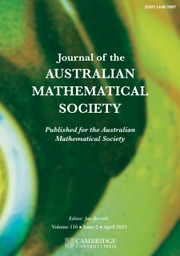Article contents
REPRESENTATIONS OF REAL BANACH ALGEBRAS
Published online by Cambridge University Press: 12 May 2010
Abstract
A commutative complex unital Banach algebra can be represented as a space of continuous complex-valued functions on a compact Hausdorff space via the Gelfand transform. However, in general it is not possible to represent a commutative real unital Banach algebra as a space of continuous real-valued functions on some compact Hausdorff space, and for this to happen some additional conditions are needed. In this note we represent a commutative real Banach algebra on a part of its state space and show connections with representations on the maximal ideal space of the algebra (whose existence one has to prove first).
MSC classification
Information
- Type
- Research Article
- Information
- Copyright
- Copyright © Australian Mathematical Publishing Association Inc. 2010
Footnotes
The first-named author acknowledges support from the Spanish Ministerio de Ciencia e Innovación Research Project Operadores, retículos, y geometría de espacios de Banach, reference number MTM2008-02652/MTM.
References
- 4
- Cited by

